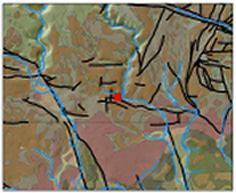Ampney Crucis
The borehole measures water level in the Jurassic Limestones of the southern Cotswolds.
Our enquiries service can help you to access groundwater level data for this well.
Hydrograph
Show data from :-
Information about the well
| Ampney Crucis | |
|---|---|
| Wellmaster ID | SP00/62 |
| NGR | 4059 2019 |
| Datum | 109.52 m AOD |
| Monitoring details | |
| Type | Groundwater Level |
| Aquifer | Middle Jurassic |
| Confinement | Unconfined |
| Depth | 61 m |
| Record | |
| Monitored by | EA Thames |
| Records commence | 1959 |
| Records end | Active |

Hydrogeological setting
The borehole measures water level in the Jurassic Limestones of the Southern Cotswolds.
The local geology is Forest Marble over Great Oolite, penetrating into Fuller's Earth.
Water levels generally rest within the Forest Marble, and are unconfined.
Well or borehole construction
The well was drilled at a diameter of 381 mm reducing to 254 mm with depth. The top 13.71 metres are lined with 254 mm diamteer casing.
Hydrograph response
The hydrograph has an annual sinusoidal response, with multiple peaks in resonse to rainfall events during the winter. It is responsive to intense summer rainfall events, and frequently shows its maxima in late spring.
Fluctuations are normally around three metres per annum. A ceiling at just over 103 m AOD may be related to local springs. Water level normally does not drop much below 99 metres, except in exceptional droughts, for instance during 1976 and 1990.
Data issues
IGS records (Institute of Geological Sciences, BGS's former name) suggest that manual readings were taken in 1957 and 1958, but these have not been found.
No data Sept/Oct 1980 and Aug/Nov 1982 due to failure of chart recorder
References
Acknowledgements
At a national level, groundwater level monitoring data is collected and managed by the Environment Agency (England), the Scottish Environmental Protection Agency, Natural Resources Wales and the Department of the Environment (Northern Ireland). Access to the data they collect (which includes many monitoring sites beyond those highlighted on these pages) and curate is online in England (DEFRA) and Scotland (SEPA).
Contact
Contact Contact enquiries for further information






